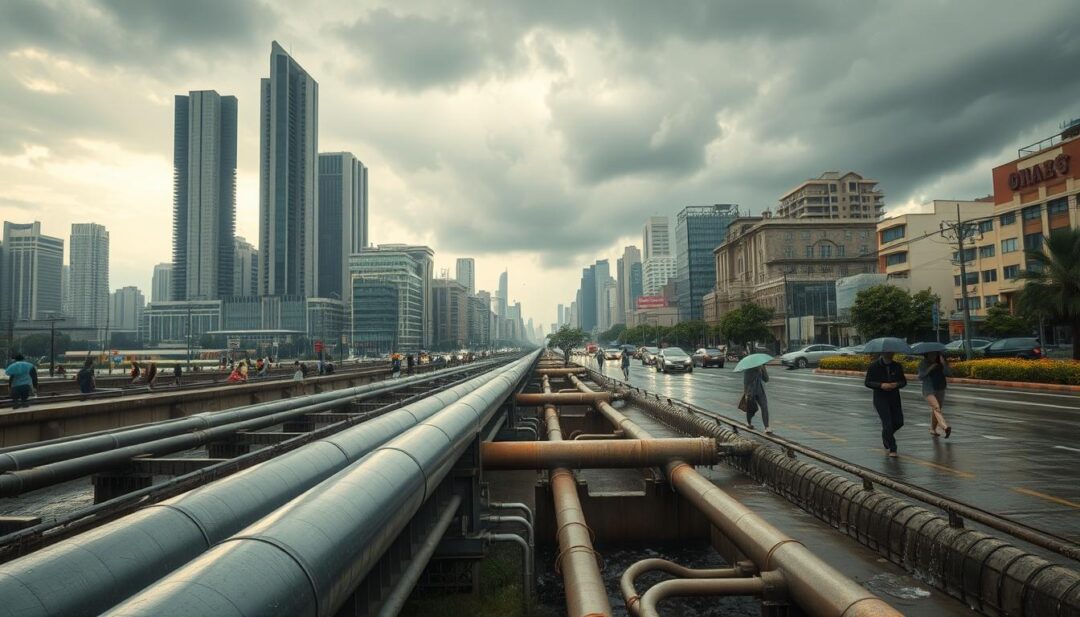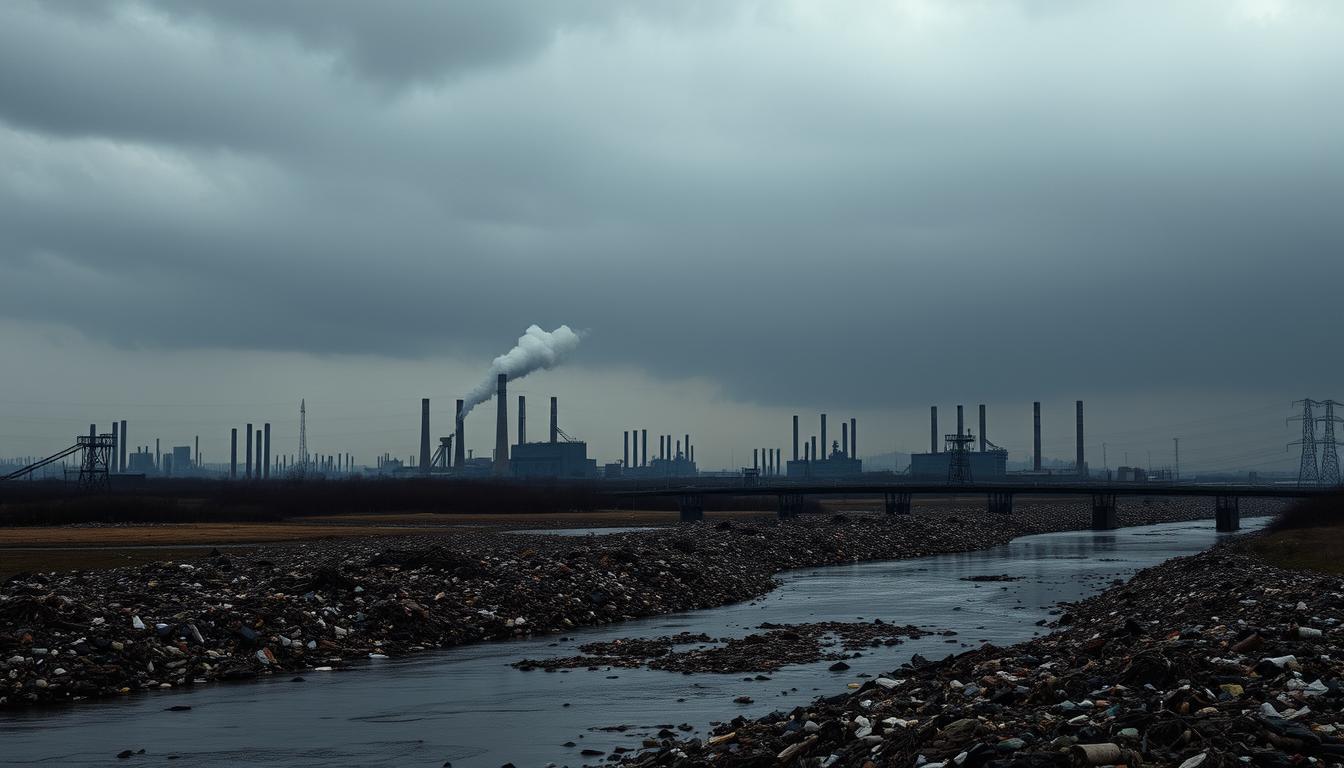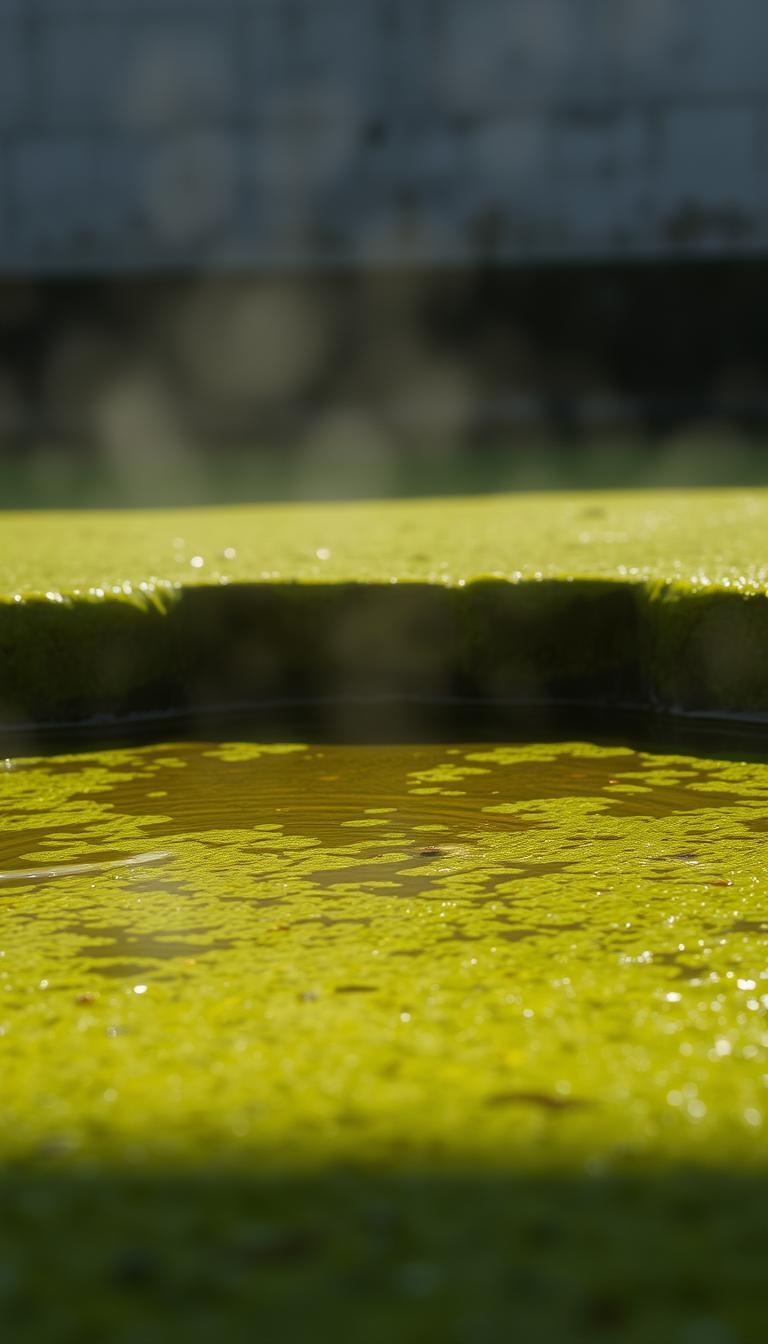How Climate Change Affects Water Quality: A Case Study
As we face the growing challenges of a changing environment, a critical question arises: Are our water resources becoming increasingly vulnerable to environmental degradation? The answer lies in understanding the complex relationship between climate change impacts on water quality and the resulting water pollution.
According to the United States EPA, climate change is significantly affecting the availability of our water resources from both a quality and quantity perspective. This raises concerns about the future of our water supplies and the need for a detailed examination of the issue.
Key Takeaways
- Rising temperatures are altering water quality.
- Increased precipitation intensity can lead to more water pollution.
- Environmental degradation affects water resource availability.
- Understanding climate change impacts is crucial for water management.
- Effective strategies are needed to mitigate water pollution.
The Growing Concern of Water Quality in a Changing Climate
As the global climate continues to evolve, the quality of our water resources has become an increasingly pressing concern. More than half of the U.S. population drinks water that’s captured and filtered by forested lands, which are increasingly contaminated due to wildland fires. This highlights the intricate relationship between land use, climate change, and water quality.
Current State of Water Resources in the United States
The current state of water resources in the U.S. is a complex issue, with various factors contributing to water contamination. Aquatic ecosystems are particularly vulnerable to changes in water quality, which can have cascading effects on biodiversity and ecosystem health.
The Intersection of Climate Change and Water Systems
Climate change intersects with water systems in multifaceted ways, influencing both the quantity and quality of water available. Rising temperatures and altered precipitation patterns are leading to more frequent and severe weather events, which in turn affect water quality. Implementing climate adaptation strategies is crucial to mitigate these impacts and ensure the long-term sustainability of our water resources.
Understanding the intersection of climate change and water systems is essential for developing effective management practices that protect our water resources for future generations.
Climate Change Impacts on Water Quality: The Scientific Consensus
The relationship between climate change and water quality is complex, involving both direct and indirect effects on water bodies. Understanding these impacts is crucial for managing water resources effectively in a changing climate.
Direct vs. Indirect Effects
Climate change affects water quality through various pathways. Direct effects include changes in water temperature and precipitation patterns, while indirect effects encompass alterations in hydrological cycles, increased runoff from extreme weather events, and shifts in aquatic ecosystems.
For instance, research shows that wildfires can alter the amount of water coming from upstream forests and change the seasonal timing of water flows, potentially causing water shortages (hydrological cycle disruptions). This highlights the intricate connections between climate change, land use, and water quality.
Key Water Quality Parameters Affected
Several key water quality parameters are influenced by climate change. These include:
- Temperature Changes: Rising air temperatures lead to increased water temperatures, affecting aquatic life.
- Dissolved Oxygen Levels: Changes in water temperature and organic matter decomposition rates impact dissolved oxygen levels.
- pH Alterations: Increased CO2 absorption by water bodies can lead to acidification, affecting pH levels.
Temperature Changes
Warmer water temperatures can lead to increased algal blooms and reduced dissolved oxygen levels, harming aquatic ecosystems. As climate change impacts on water quality continue to grow, understanding these dynamics is essential for mitigating adverse effects.
Lower dissolved oxygen levels can result from higher water temperatures and increased organic matter decomposition. This can lead to “dead zones” where aquatic life cannot survive, exacerbating water pollution issues.
pH Alterations
Changes in pH levels can affect the availability of nutrients for aquatic life and the toxicity of certain pollutants. Monitoring these changes is crucial for maintaining healthy water bodies and mitigating the effects of climate change on water quality.
In conclusion, the scientific consensus underscores the significant impacts of climate change on water quality through various direct and indirect pathways. Addressing these challenges requires a comprehensive approach to managing water resources in the face of a changing climate.
Case Study Methodology and Research Approach
This section outlines the research methodology used to study the relationship between climate change and water quality in the Great Lakes Basin.
Study Area Selection: The Great Lakes Basin
The Great Lakes Basin was chosen for its ecological significance and vulnerability to environmental degradation. Its large size and diverse water resources make it an ideal location for studying the impacts of climate change on water quality.
Data Collection Methods and Timeline
Data collection involved a combination of field measurements and remote sensing techniques over a period of five years (2018-2022). This timeframe allowed for the capture of variability in climate conditions and their effects on water quality.
Analysis Techniques and Statistical Methods
Analysis techniques included regression analysis and time-series analysis to identify trends in water contamination and correlate them with climate variables. The results are presented in the following table:
| Parameter | Method | Result |
|---|---|---|
| Water Temperature | Regression Analysis | Significant increase |
| Precipitation | Time-Series Analysis | Variable trends |
| Water Quality Index | Composite Index | Deterioration observed |
These methods enabled the development of climate adaptation strategies tailored to the region’s specific needs.
Temperature Rise and Its Cascading Effects on Water Bodies
The increasing temperature is altering the delicate balance of aquatic ecosystems. As global temperatures continue to rise, the effects on water bodies are becoming more pronounced, leading to a cascade of changes that impact water quality and ecosystem health.
Thermal Stratification in Lakes and Reservoirs
Rising temperatures can lead to thermal stratification in lakes and reservoirs, a phenomenon where warmer water floats on top of cooler, denser water. According to the US EPA, this stratification can affect the distribution of nutrients and oxygen, potentially harming aquatic life.
Impacts on Aquatic Biodiversity and Ecosystem Health
The changes in water temperature and quality can have significant impacts on aquatic biodiversity. Many species are sensitive to temperature changes, and shifts in thermal regimes can alter the distribution, behavior, and survival of aquatic organisms, ultimately affecting ecosystem health.
Correlation Between Air and Water Temperature Trends (2000-2022)
Analyzing the correlation between air and water temperature trends over the past two decades reveals a concerning pattern. Studies have shown that rising air temperatures are closely linked to increasing water temperatures, exacerbating the impacts on water quality and hydrological cycle disruptions.
Understanding these changes is crucial for developing effective strategies to mitigate the effects of climate change on water quality. By examining the correlation between air and water temperature trends, researchers can better predict future changes and inform management practices to protect aquatic ecosystems.
Precipitation Pattern Changes and Water Contamination
As climate change alters precipitation patterns, water contamination becomes a growing concern. Changes in rainfall and snowfall patterns are affecting the quality of water sources across the United States, posing significant challenges for environmental and public health.
Extreme Rainfall Events and Runoff Pollution
Extreme rainfall events can lead to runoff pollution, contaminating water sources with sediments, nutrients, and pollutants from agricultural lands, urban areas, and other sources. According to Yale E360, “Heavy rainfall can overwhelm urban drainage systems, causing sewage overflows and flushing pollutants into nearby water bodies.” This not only degrades water quality but also poses risks to aquatic ecosystems and human health.
“The increased frequency of extreme rainfall events is a major driver of water pollution, as it leads to more runoff and greater stress on water treatment infrastructure.”
Drought Periods and Concentration of Pollutants
Conversely, drought periods can also impact water quality by concentrating pollutants in reduced water volumes. During droughts, the decreased flow in rivers and streams results in higher concentrations of contaminants, making the water more vulnerable to pollution. This situation is particularly challenging for water treatment plants, which must work harder to remove contaminants from the reduced water supply.
Case Examples from Different US Regions
Different regions across the United States are experiencing unique challenges related to precipitation pattern changes and water contamination. For instance:
| Region | Precipitation Pattern Change | Impact on Water Quality |
|---|---|---|
| Midwest | Increased frequency of extreme rainfall events | Higher levels of agricultural runoff, contaminating local waterways |
| Southwest | Prolonged drought periods | Concentration of pollutants in reduced water volumes, affecting water treatment |
| Northeast | More frequent and intense storms | Combined sewer overflows, leading to contamination of urban water bodies |
Understanding these regional variations is crucial for developing effective climate adaptation strategies to mitigate water pollution and protect environmental health.
Climate Change Impacts on Coastal Water Quality
The impact of climate change on coastal water quality is a pressing concern, with far-reaching consequences for ecosystems and human health. Coastal areas are particularly vulnerable to the effects of climate change, including sea level rise, increased storm intensity, and changes in precipitation patterns.
Sea Level Rise and Saltwater Intrusion in Aquifers
Sea level rise is causing saltwater intrusion into freshwater aquifers, threatening drinking water supplies. According to Yale E360, this issue is becoming increasingly prevalent, posing significant challenges for coastal communities that rely on these aquifers for their water needs.

Storm Surge Effects on Estuarine Water Quality
Storm surges associated with extreme weather events can significantly degrade estuarine water quality by introducing large amounts of sediment, nutrients, and pollutants into these sensitive ecosystems. This can lead to harmful algal blooms and decreased biodiversity.
Implications for Coastal Communities and Marine Ecosystems
The degradation of coastal water quality has profound implications for both coastal communities and marine ecosystems. It can impact fisheries, tourism, and human health, while also threatening the rich biodiversity of these regions.
| Impact | Consequence | Affected Group |
|---|---|---|
| Sea Level Rise | Saltwater Intrusion | Coastal Communities |
| Storm Surges | Water Pollution | Marine Ecosystems |
| Extreme Weather | Infrastructure Damage | Coastal Infrastructure |
Agricultural Runoff and Climate-Induced Water Pollution
Agricultural runoff, exacerbated by climate change, poses a significant threat to water bodies. The changing climate is altering agricultural practices in ways that can lead to increased water pollution. As temperatures rise and precipitation patterns shift, the risk of pollutants entering waterways through runoff increases.
Shifts in Growing Seasons and Fertilizer Application
Changing growing seasons due to climate change are affecting fertilizer use patterns. Farmers may apply fertilizers at different times or in different quantities, potentially leading to increased runoff during heavy rainfall events. This can result in excess nutrients entering water bodies, causing eutrophication and harmful algal blooms.
Extreme Weather Events and Pesticide Runoff
Extreme weather events, such as intense storms, are becoming more frequent due to climate change. These events can lead to increased pesticide runoff into water bodies. According to a report by Yale E360, changing growing seasons and extreme weather events are indeed increasing pesticide runoff into water bodies. This not only affects aquatic life but also contaminates water sources used for drinking and irrigation.
Strategies to Mitigate Agricultural Runoff
To mitigate the effects of agricultural runoff on water quality, several strategies can be employed. These include implementing best management practices such as cover cropping, buffer strips, and precision agriculture techniques. Additionally, improving soil health through conservation tillage and organic amendments can reduce the risk of runoff. Policy initiatives and farmer education programs also play a crucial role in promoting these practices.
By adopting these strategies, we can reduce the impact of agricultural runoff on water pollution and protect our water resources for future generations.
Urban Water Systems Under Climate Stress
Climate stress is pushing urban water systems to their limits, necessitating innovative adaptation strategies. Urban areas are particularly vulnerable to the impacts of climate change, with water quality being a significant concern.
Combined Sewer Overflow Challenges
During heavy precipitation events, combined sewer overflows (CSOs) pose a significant threat to urban water quality. The US EPA has noted that CSOs can lead to the contamination of water bodies with pollutants, including bacteria, viruses, and other pathogens. Innovative solutions such as green infrastructure can help mitigate these impacts by reducing stormwater runoff.

Heat Island Effects
The urban heat island effect can exacerbate water quality issues by increasing water temperatures, which in turn can lead to algal blooms and decreased dissolved oxygen levels. Strategies to mitigate the heat island effect, such as increasing urban vegetation and using cool pavements, can help protect urban water resources.
Innovative Urban Water Management
To address the challenges posed by climate change, cities are adopting innovative urban water management approaches. These include the use of real-time monitoring systems and green infrastructure to manage stormwater runoff and improve water quality.
| Strategy | Description | Benefits |
|---|---|---|
| Green Infrastructure | Use of natural or semi-natural systems to manage stormwater | Reduces runoff, improves water quality |
| Real-time Monitoring | Continuous monitoring of water quality parameters | Enables rapid response to water quality issues |
| Cool Pavements | Use of materials that reduce surface temperature | Mitigates heat island effect, improves water quality |
Adaptation Strategies for Protecting Water Quality
Protecting water quality in the face of climate change requires a multi-faceted approach that incorporates various adaptation strategies. Effective policy and regulatory frameworks are crucial for protecting water quality, as emphasized by the US EPA.
Policy and Regulatory Frameworks at Federal and State Levels
Robust policy and regulatory frameworks at both federal and state levels are essential for addressing water quality challenges. The US EPA plays a vital role in setting national standards, while state-level regulations can be tailored to address specific regional concerns.
“The Clean Water Act has been instrumental in improving water quality in the United States, but continued efforts are needed to address emerging challenges.”
Key components of effective policy frameworks include:
- Stringent water quality standards
- Regular monitoring and enforcement
- Public participation and transparency
Technological Solutions and Real-time Monitoring Systems
Technological advancements offer promising solutions for enhancing water quality monitoring and management. Real-time monitoring systems enable swift responses to changes in water quality, reducing the risk of pollution.
| Technology | Application | Benefits |
|---|---|---|
| Satellite Imagery | Water quality monitoring | Wide coverage, real-time data |
| Sensor Networks | Real-time monitoring | High accuracy, timely alerts |
| Data Analytics | Predictive modeling | Informed decision-making |
Community-Based Approaches to Water Protection
Community-based initiatives are vital for protecting water quality, as they foster local engagement and tailored solutions. These approaches can include public education campaigns, watershed restoration projects, and collaborative management practices.
Examples of successful community-based initiatives:
- Watershed restoration projects
- Public education and outreach programs
- Collaborative management practices among stakeholders
By combining policy frameworks, technological solutions, and community-based approaches, we can develop comprehensive strategies for protecting water quality in the face of climate change.
Conclusion: Addressing the Future of Water Quality in a Changing Climate
Climate change is significantly impacting water quality, affecting aquatic ecosystems and human health. Our case study highlights the far-reaching consequences of climate change on water contamination, from rising temperatures to extreme weather events.
Effective adaptation strategies are crucial to mitigate these impacts. According to Yale E360, a comprehensive understanding of climate change impacts is necessary to address the future of water quality. This involves implementing policy and regulatory frameworks, leveraging technological solutions, and promoting community-based approaches to water protection.
By understanding the complex relationships between climate change, water quality, and aquatic ecosystems, we can develop targeted solutions to safeguard our water resources. Continued research and action are necessary to protect the health of our water bodies and the ecosystems they support.


